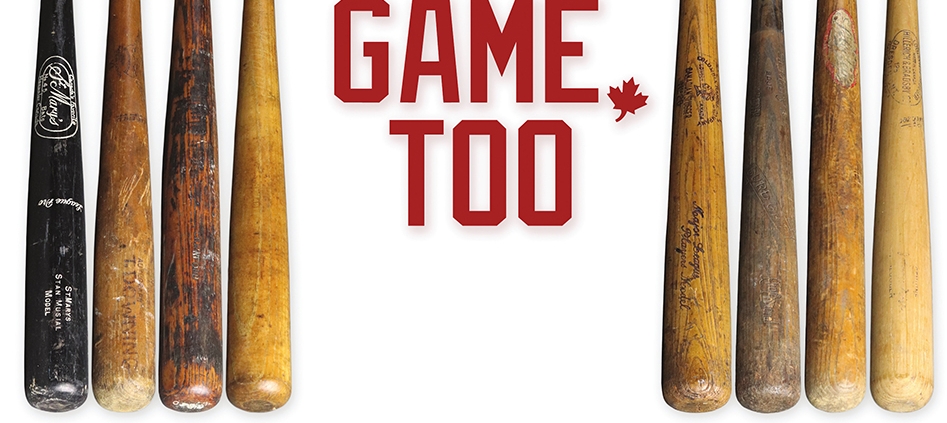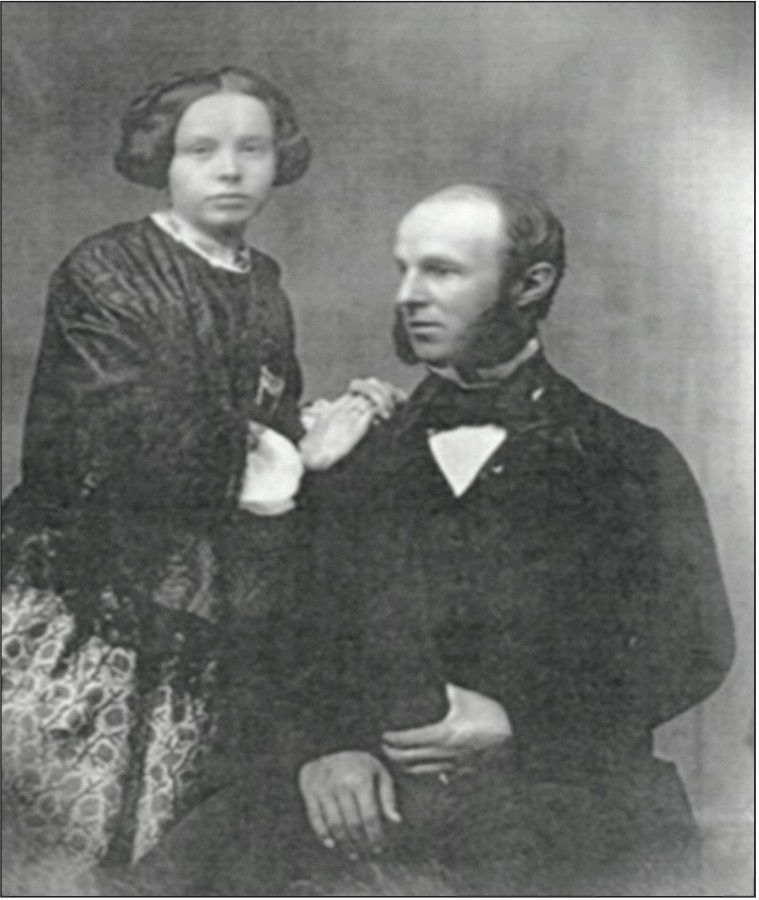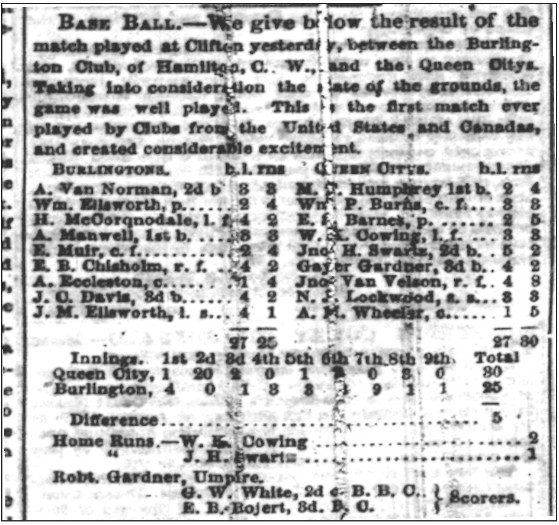The First Ever International ‘Base Ball’ Game
This article was written by William Humber
This article was published in Our Game, Too: Influential Figures and Milestones in Canadian Baseball (2022)
The original Home Run Baker: Ottawan Godfrey Phipps Baker and his wife Elizabeth. (Author’s collection)
In a Niagara Frontier journal essay (Summer 1964), noted Buffalo historian Joseph Overfield described the first-ever international baseball match as being played between the Burlingtons of Hamilton C.W. (Canada West, or today’s Ontario), and the Queen Citys of Buffalo, New York, on August 17, 1860. The Queen Citys were victorious 30-25 in a place called Clifton, as described in the Buffalo Morning Express. For many years, however, the location of Clifton remained uncertain.1
Historians in the Society for American Baseball Research initially wrestled with Clifton’s location. A detailed survey of early games in upper New York state released in 2008 by Craig Waff described the place as Clifton, NY (for New York). Version 11 of SABR’s full Protoball Chronology loaded in April 2010 in its working chronology for Ballplaying in Canada was more circumspect, noting, “Clifton NY is not a location found near Buffalo. Perhaps it was the former name of a section of the city. An area called Clifton Heights is on Lake Erie SW of Buffalo.” Neither was definitive, however. Uncertainty surrounded the location until Canadian researchers looked within their own country and noted that until the 1880s Niagara Falls, Canada, went by the name of Clifton, a description still current today in the city’s tourist enclave of Clifton Hill.2
The location should not have been hard to uncover. There had been several reports in the New York Clipper newspaper3 the year before of cricket matches played by Clifton, C.W. One was against their nearby Canadian neighbor, Thorold, but more significantly, the Clipper, under the headline, CLIFTON VS ST. GEORGE, wrote, “… Clifton, C.W. defeated the latter of Buffalo, N.Y. in a match played at Clifton, on the 25th [July] … by three wickets.”
Just as Canadians would later be surprised to discover that the first international game of their favorite sport, hockey, had been played in Burlington, Vermont,4 so might the possibility of a non-American location for the first international game of their national game, baseball, have been a surprise to US-based researchers. Our deeply held belief systems do at times throw us a curve!
We must give some pause to this conversation, however, by clarifying our terms. While baseball’s ultimately successful New York form barred the practice of soaking,5 any game (whether a variation of the soaking game, or possibly one using a gradually harder ball), would have been a first for international recognition as long as it was played between formal teams from different national jurisdictions.
Two such games apparently meeting these criteria need, therefore, to be discounted. In 1859 a visiting team of prominent English cricketers had arrived in North America to play local squads in the Northeastern United States and in what today is eastern Canada.6 The English were so good they often allowed their Canadian and American rivals to place 22 men in defensive positions when the Englishmen batted, rather than the normal 11, and still the visitors won. Near the end of their tour, there were proposals for them to play a team of Americans at baseball, but finances proved too big a hurdle.
Instead, the English split into two teams, then filled out their lineups with available local Americans and at least one Canadian, Godfrey Phipps Baker, an Ottawa cricketer and that city’s postmaster.7 They played a game of baseball in Rochester, New York. The result was immaterial, but English newspapers borrowing their box score from Porter’s Spirit of the Times gave the match an international designation. While the nationality of the players was multinational, the teams were not formal baseball organizations, nor were they teams representing different national entities. For what it’s worth, the Canadian Godfrey Baker hit the first home run in the game, an achievement more notable had this been the first such international baseball game.
The other candidate was a match in Schenectady, New York, on May 19, 1860, between teams described, by the Sunday Mercury sporting paper as New York vs. Canada, and which were listed as the Mohawk Club of Schenectady and the Union Club of Upper Canada. The Upper Canada appellation had been discarded geographically by the act of union between Upper and Lower Canada in 1841. At that time Upper Canada had become known as Canada West (Quebec was Canada East), a name later replaced by Ontario in 1867 following Canada’s formal recognition as a national entity. No record of this team exists in Canada, and if they had come from north of the border for this one encounter they would, as was the common practice of the day, have been known by a specific place, and not by an out-of-date generic locale.
SABR researcher Robert Tholkes finally set the record straight in 2014.8 The Sunday Mercury item on the game involving the “Union Club of Upper Canada” in Schenectady on May 19, 1860, was also reported in the Schenectady Daily News of May 22, 1860. It stated, “THE MATCH GAME OF Base Ball played Saturday afternoon between the Mohawk club of this city and the Union Club of the Junior Class of Union College, resulted in the following score: Mohawk, 31 runs.” Tholkes wrote, “The article then listed the players, [but] without the box score sent to the Sunday Mercury. These matched the names in the [earlier] box score. Why the college club decided to pretend to be from Canada is unknown. Perhaps one or more of the players were Canadian. So we can reject any claim for this game having been an international first.”
None of this is particularly surprising. Most games were played in regionally confined outposts throughout North America, and significantly this includes locations in the “British Empire’s Canadian Province.” While such games would have featured players born in more than one country, they were either intrasquad affairs or between clubs specific to a shared territory, and within the same nationally defined jurisdiction. None was international. Likewise, expatriates from either country may have formed local squads to play other local teams, but since these would have been immigrants now residing in a host country, such games cannot be considered international. Finally, local squads of cricketers were known to often play simple games of baseball as a warm-up for their regular cricket match. Despite the possible international makeup of players, these were not formally defined baseball teams.
Our description requires that the two competing teams qualifying for status as participants in an international game must be formal baseball teams, whose primary identity is as such, and who each, in their name and regional location, represent a definable geographic territory distinct in national recognition from the other. It is/was not necessary that such places have formal status as independent national entities, but if they were a colony of another nation, they had to be distinct from the one against which they were playing. As such, the Hamilton Burlingtons game with the Queen Citys of Buffalo meets our criteria, in much in the same way as a game between a team largely but not exclusively of New York cricketers from the St. George’s Club and a Canadian team from the Toronto club and the Upper Canada College eleven qualifies as the first ever international match for that sport in 1844.9
WILLIAM HUMBER’s five books on baseball include Diamonds of the North: A Concise History of Baseball in Canada (1995). He has been a facilitator since 1979 of an in-class and now online subject Baseball Spring Training for Fans, is an inductee into Canada’s Baseball Hall of Fame (2018), and was appointed to the Order of Canada (2022) for his baseball research. He finds it all a tad overwhelming.
Report of the match played at Clifton on August 17, 1860. (Buffalo Morning Express, August 18, 1860)
Notes
1 Joseph Overfield, Niagara Frontier, Summer 1964: 59-60; Buffalo Morning Express, August 18, 1860.
2 “In October of 1881, at the request of its residents, the former Town of Clifton [Ontario, Canada] received permission to change its name to the Town of Niagara Falls. By 1881, the population of the Town of Niagara Falls was 2,623 citizens.” From https://www.niagara-fallsinfo.com/niagara-falls-history.
3 New York Clipper, August 13, 1859.
4 https://www.mychampiainvalley.com/news/local-news/this-place-in-history-first-international-hockey-game/; or http://hockeygods.com/blog/hockeyhistory/The_1st_lnternational_lce_Hockey_Game_1886.
5 Soaking was the “old-style” practice of using a softer ball that could be thrown at a runner between bases. The runner was out if hit by the ball.
6 Fred Lillywhite, English Cricketers’ Trip [1859] to Canada and the United States (London: F. Lillywhite, 1860).
7 The Era, December 4, 1859: 13. As sourced online through the British Newspaper Archives, https:// www.britishnewspaperarchive.co.uk/viewer/bl/0000053/18591204/034/0013.
8 Email from Robert Tholkes to William Humber, April 16, 2014.
9 John I. Marder, The International Series: The Story of the United States v Canada at Cricket (London: Kaye & Ward, 1968), 16-25.




